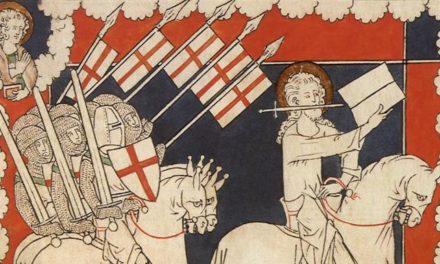This episode is titled “Writings.”
The history of the Christian Faith & Church inevitably has to deal with the importance of Books. From its earliest days the Faith has been intimately linked to the Scriptures. At first, Scripture was the Hebrew Bible or what is known today as the Old Testament. But other writings were added to the Church’s Bible as the years passed.
The question of what writings to include in the Bible was one of the major topics of discussion during the first 4 centuries. But the question of what ought to be included or excluded is not nearly the contentious debate skeptics claim. With rare exception, church leaders generally agreed what texts comprised Scripture. Their reluctance to make an official pronouncement was because humility prohibited them claiming the authority to do so. Still, by the 4th Century, Church leaders recognized time was running out on those who were in a position to make the needed determination.
Following the age of the martyrs, the next period of Church history was marked by theological challenge. It was crucial local congregations have a standard to go by, an authoritative body of doctrine by which to evaluate what was being taught. That authority was the Bible.
Christians started with those Scriptures the Jews already revered as God’s Word, the Tanach, or as Christians referred to it, the OT. To this base of 39 books, believers added another set of writings they called the New Testament. Together, these 2 Testaments comprise what’s called the “Canon of Scripture.”
Canon means a measuring rod, as in a ruler. The Canon of Scripture is the standard for measuring if something is straight, if it aligns with truth. The Bible was esteemed Truth because it was regarded as God’s inspired & inerrant Word.
And that’s what proved such a daunting challenge to Church leaders as they considered what to include in the NT Canon. Who were they to decide what was inspired by the Holy Spirit & ought to be regarded as the standard by which to evaluate all else? Still, the task was necessary so they developed a criteria by which to decide what ought to be included in the Canon. Their reasoning went like this . . .
First was the OT canon of Jewish Scriptures. Then Jesus came as the Word of God made flesh. Though Jesus wrote no books, His life and words were written on the hearts and minds of the Apostles, whose teaching in both oral & written form was accepted as authoritative.
Early evidence makes it clear that letters from the Apostles were circulated & read in the churches, being accepted as laying down the norms of Christian belief and practice. A ravenous hunger for stories of Jesus moved the Apostles to develop a standard oral tradition that we see today forming the core of the Synoptic Gospels of Matthew, Mark, & to a certain degree, Luke.
But how do we get to the 27 books that form today’s NT canon? What criteria did Church leaders use when they finally identified those books?
1St – A candidate writing for inclusion had to have a self-identifying quality about it as having been inspired by God. It had to possess a certain power to affect the lives of readers toward God.
2nd – A candidate writing had to have a long reputation among the churches for having been used in worship to the edification of believers.
3rd – A writing had to have a close connection to an Apostle. If not written by the Apostle himself, was the author a close associate of an Apostle & did it bear the mark of the Apostle’s influence?
For example . . .
Luke wasn’t an apostle but his Gospel and the Book of Acts are included in the NT because he was a close associate of the Apostle Paul and had interviewed the other Apostles in researching Jesus’ story.
Mark wasn’t an apostle, but received his information about Jesus from the Apostle Peter. He was also a companion of Paul’s; sort of. But that’s another story.
On the other side of the issue, in the late 1st Century, Clement, the 2nd or 3rd pastor at Rome, wrote a letter to the church at Corinth. That letter was read often at Corinth in the years that followed and proved of great benefit. But because Clement wasn’t deemed to have an Apostolic connection, his letter wasn’t included in the NT canon. There wasn’t even much debate if it should be. It didn’t pass the test, so it wasn’t included.
Because the test of Apostolic origin was crucial to canonical books, the Church leaders of the late 2nd Century realized time was running out on reliable witnesses who could confirm a writing’s Apostolic authority. The pressure was on to put their imprimatur of acceptance on those works connected to the Apostles.
Since we’re speaking about the writings that made it INTO the NT, let me mention a couple of influential works that didn’t but were nevertheless crucial in shaping the early understanding of the Faith.
One of the most important extra-Biblical writings of the early church was the Didache. We don’t know when it was written but it was in use as a manual for church life by the 1st decade of the 2nd C. The Didache gives instructions for how to conduct services, worship, baptisms, Communion, and what was turning into a growing problem, how to exercise church discipline. The Didache also had instructions for how to discern heresy. The last section contains instructions for how to live in light of the Lord’s return – which lends tremendous weight to the idea of imminency.
Pardon me for a little personal comment here but it’s hard to resist.
But even before I make that comment, I need to comment – on my comments. And I need to – because I got a great email from a faithful subscriber who told me he’s recommend the podcast to a lot of friends & acquaintances. A few of them told him they enjoyed the podcast, until my particular bias came out. Then, I guess they stopped listening. And he was bummed, because he likes the podcast and puts up with my occasional personal commentary, because well, he mostly agrees with it, but also because the rest of the podcast steers a pretty unbiased course through the subject matter.
We had a nice little email dialog and I shared WHY I DO make occasional comments. I realized while writing him that I ought to share that here. He thought it was a good idea. So here goes . . .
I share infrequent remarks & personal opinion for 2 reasons . . .
1) You get to know me a little better. With my favorite podcasts, after I’ve listened for a while, I find myself wanting to know more about the author. So when they share little tid-bits about themselves, it’s fun & makes the whole experience more relational. I don’t want to hear a whole podcast about their cat, but hearing they have one makes the author more real, rather than just a formless voice.
2) It’s good for us to hear the opinions of those we differ with, in their own voice, rather than told what they said or believe by those of our own persuasion. The followers of Jesus ought to be aimed at relational maturity, & that means accepting there’s a big world out there filled with people who don’t all agree with us. Learning to respect them and let them speak, without feeling like I’ve betrayed some kind of loyalty to God is crucial. I can listen w/o agreeing. In fact, I need to, because often times, by listening, I realize what others TOLD me they believed, ISN’T! And even if it is; persuading them isn’t going to be furthered by shutting them off & turning away because I don’t agree.
If you’ve gone to the sanctorum.us website, you probably know I’m a pastor of an Evangelical non-denominational church called CC in Southern CA. So my comments will be what can generally be called a conservative, Protestant position. If you’re interested in more detail, you can visit our church website, which you can track down by going to the sanctorum.us website. When I do make one of those comments, I’ll try to remember to preface it with a disclaimer, a notice, so you can make whatever mental adjustment you need to. I would just ask that you hear me out. You don’t have to agree. I don’t expect everyone will. But please don’t toss the rest of the podcast for the sake of what I really do think is an important part of making this podcast better by being more personal.
So, with all that preface – now to it. We were talking about how the last section of the Didache is instructions for how to live in light of the Lord’s return – which lends tremendous weight to the idea of imminency.
I’m rather tired of hearing that “No one believed in a pre-tribulation rapture until Margaret MacDonald & John Darby made it up in the 1830’s.” The vast majority of people who say that do so because they heard someone else say it. They haven’t done any historical work to see if it’s true. It isn’t. And even it if WAS – it makes as much sense as saying Sola Scriptura & Sola Fide were made up by Martin Luther & John Calvin in the 16th C. That’s absurd! Does the neglect of a Biblical reality for hundreds of years make it any less true? All John Darby did was restore much needed attention to a neglected belief of the Apostles & Early Church. A belief amply supported by the sense of urgency found in the Didache.
Okay, end of commentary; back to the history . . .
Another writing early Christians used to amplify their faith was called The Shepherd of Hermas. This work from the late 1st to mid-2nd C was written by Hermas, a former slave who says an angel appeared to him in the form of a shepherd & dictated the contents of the book.
It contains 5 visions, 12 commands & 10 parables. It’s highly allegorical and addresses problems that divided the Church, calling the faithful to repent.
The Shepherd was so influential that a handful of the Early Church Fathers thought it ought to be included in the NT. But its failure, like Clement’s Letter to the Corinthians, to hold a clear Apostolic connection precluded its inclusion.
Another event, a highly unfortunate situation, forced the hand of the Church leaders in moving to complete the canon.
A heretic named Marcion [Mar-key-own] set up a counterfeit church that paralleled the Apostolic Faith. But he proposed 2 gods; A wrathful, angry, violent God of the Jews & OT, and a loving, kind, benevolent Father-God of the NT & Christians. Marcion rejected the OT and those NT books he considered too Jewish; books like Matthew, Mark, Acts, Hebrews, 1 & 2 Timothy, & Titus. Marcion’s Bible was a highly-edited Gospel of Luke & a handful of Paul’s letters.
Though the Church excommunicated Marcion in AD 144, his rejection of all things Jewish carried a certain resonance with some Gentile believers persecuted by Jews. Marcion formed his counterfeit church from their ranks. It was the heretical Marcion’s pre-emptive move of identifying which books were Scripture that forced Church leaders’ hand to provide an official list of genuine Christian Scripture.
The OT was retained & reaffirmed as God’s Word, & for the most part the books we recognize as the NT Canon today. I say, “for the most part” because there were a few books that continued to be debated until the Council of Carthage closed the Canon in 397 with the 27 books of our NT. If this sounds like a late date to complete the Canon, know that the list the Council settled on had been in circulation for many years prior to the official statement at Carthage.
A couple of decades after the heresy of Marcion, another challenge to orthodoxy arose. Around 160, 2 women and a man joined forces in Phrygia, a region of central Turkey. They formed a new movement based on what they claimed was the prophetic voice of God. Maximilla, Prisca, & Montanus led what we could call an early hyper-Pentecostalism that split the church.
The Montanists’ central message was the soon return of Christ & the need for believers to get ready. They were to do so by a strict asceticism that included much fasting, eating only dry foods, (I guess moist food was sinful because it was too easy to chew) and the requirement to abstain from sex, even including marital sex. Montanists were encouraged to relish persecution; holding it to be a badge of genuine faith and loyalty to God.
The Montanists presented such a challenge that Church leaders convened some of the Church’s first councils, known as “synods”, to decide how to respond to its growing popularity. It was decided that the excesses of the New Prophets were too extreme and they were excommunicated, though the specific reasons for doing so have been lost to us. All we know is that an official split occurred between the Montanists and the Apostolic Church. The split was so clear, when Christians and Montanists were both executed in the same arena, they died for the same God but tried to avoid being eaten by the same animals, lest their remains mingle in the belly of the beasts.
Yeah, I know! It’s amazing how far Christians will go to carve themselves up into different groups. It’s nothing new. It’s been going on since their earliest days.
If you live in an urban or suburban community, you likely drive around town and see several church buildings with different signs & labels. Christianity is a religion composed of not dozens à but hundreds of sects. And while services may be similar in many of those local churches, the can also differ widely in style, culture, values, & doctrine. For instance, some are sedate & composed, putting more emphasis on rationality and the centrality of the sermon or the practice of a liturgy. Others allow and may even encourage a more emotional encounter with God, so music & worship take a more active place in the service. I’m generalizing widely here. My point is that both churches may be packed with people attending because while they’re culture is on opposite ends of the spectrum, each appeals to a certain group of people. It isn’t that one is right & the other is wrong. They may both be either. The point is – people are different, so there are places for them to go to be brought closer to God.
In studying the Montanists, I wonder if there isn’t a bit of this dynamic that happened with their success in certain places. You see, their leader, Montanus, before coming to faith in Christ was a priest either of Apollo or Cybele. The worship of both gods was marked by their priests & priestesses being given to ecstatic trances & urges. Whether these altered states of consciousness were induced by hallucinogenic drugs, extreme meditative rituals, or outright demonic activity – the person in ecstasy would enter a trance where the eyes would roll up into the head, their bodies would go rigid, their voice would alter, & they’d make solemn pronouncements as though by the voice of a god.
This was Montanus’ background. There’s a question about the genuineness of his conversion. Did he really come to faith or like some of the other aberrant groups at this time, did he see the rising popularity of Christianity and simply adopt some of its terms and forms while carrying on under his old practices? Did he just rebrand his demonically-induced ecstasies?
That’s what some historians conclude. Some of what Montanus, along with Prisca & Maximilla went on to prophecy was goofy. But some of the charges leveled against Montanus reflected his practices BEFORE his conversion. It was his critics who accused him of making his post-conversion prophetic announcements in the old Cybelline trance-like state. Others said that he did NOT operate that way after coming to faith; that he renounced his pagan past. But that he, like his supporters, was someone who yearned for a more emotionally engaged & experiential faith & that the work of the Holy Spirit, so prominent in the earliest church, must not be forfeited. It was in danger of that very thing as the Faith had to contend with hostile government officials and an emerging mix of aberrant groups. All the energy by the church’s brightest leaders seemed to be going into the cerebral, the doctrinal, the apologetic – and this emphasis on the mind was numbing the heart of the Faith. The Montanists wanted to see the Holy Spirit active & present in the Church’s midst. Sadly, their claims to being the ESPECIALLY anointed led to excesses, and a discrediting of their movement – just as has happened in more recent times with the wild pronouncements & false prophecies of some of the hyper-charismatics.
The decision to excommunicate the Montanists was anything but unanimous among Church leaders. Many believed that while the New Prophets had indeed gone too far in their excessive emphasis on asceticism, their renewal of the use of spiritual gifts was a return to the primitive version of Christianity practiced by the Apostles & described in the Book of Acts. The early Church father Tertullian, pastor of Carthage, began as a Montanist.
What brought the Montanists into the greatest disrepute was the failure of some of their prophecies about impending events. This and their ultra-strict legalism earned them the label of being highly aberrant, if not heretical.
Though it was right for Church leaders of the late 2nd Century to censure the Montanists for their excesses, they may have gone too far in labeling them “heretics.” Because the Montanists put such emphasis on the work of the Holy Spirit, rejecting Montanism tended to put a damper on the exercise of spiritual gifts. An unfortunate turn at a time when Christians needed every bit of help they could get.
In our next episode, we’ll consider what was probably the greatest doctrinal challenge to the Early Church; the heresy known as Gnosticism. This is an important subject because while Gnosticism was eventually defeated by orthodoxy and went into a long hiatus, it’s seen a revival in recent years due to the combined influence of modern novelists and some recent discoveries of their literature which critics of Christianity have latched on to in an attempt to muddy the waters on what original believers really believed.






Interesting comment. Question:does immanence equal pre-trib rapture?
Also: Why do so many who believe in the pre tribulation. Rapture get bothered when they find out that you don’t even to the point of cutting off fellowship and or implying that you might not be saved?
Dear Zionsharp,
No – Immanence does not equal a pre-trib rapture. But it does militate strong for a Pre-Trib position as posited against either a Mid-Trib or Post-Trib position because both those positions require elements of the Tribulation to be enacted prior to the Rapture while a pre-trib position says the catching up takes place before any of those events thus “imminent.”
I agree with you that it’s sad when people make non-essentials a cause to be contentious about. While we must agree on the essentials, we’re free to disagree on the non-essentials and ought to do so charitably & while maintaining a modicum of respect for each other. Let’s all be careful to know what we believe & why & how to dialog without going to war with each other over debatable things. BTW, in my experience, being acrimonious doesn’t belong to just one group; every camp has it’s over-zealous defenders.
Loving the teaching, your comments make it more interesting – we shouldn’t be afraid of truth, wherever it is found… part of the ministry of Restoration (?)
Thanks for explaining your inclusion of personal opinions. Thanks also for explaining events in a clear and simple manner!